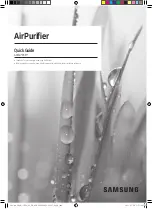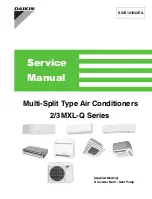
English
10
•
Nitrogen should be set to 0.02 Mpa (0.2 kg/cm
2
) with a pressure-reducing valve if brazing while inserting
nitrogen into the piping.
(Refer to Fig. 9)
7. DRAIN PIPING WORK
1. Rig drain piping (Refer to Fig. 10, Fig. 11)
•
As for drain work, perform piping in such a manner that water can be drained properly.
As for drain piping, the connection can be made from three different directions.
•
Employ a pipe with either the same diameter or with the diameter larger (excluding the raising section)
than that of the connecting pipe (PVC pipe, nominal diameter 25 mm, outside diameter 32 mm).
•
Keep the drain pipe short and sloping downwards at a gradient of at least 1/100 to prevent air pockets
from forming.
•
If the drain pipe cannot be sufficiently set on a slope, execute the drain raising piping.
•
To keep the drain pipe from sagging, space hanging wires every 1 to 1.5 m.
CAUTION
Water pooling in the drainage piping can cause the drain to clog.
•
Use the attached drain hose (3) and Metal clamp (1).
•
Insert the drain hose into the drain socket up to the base, and tighten the Metal clamp securely within
the portion of a white tape of the hose-inserted tip. Tighten the Metal clamp until the screw head is less
than 4 mm from the hose.
•
Wrap the attached sealing pad (6) over the Metal clamp and drain hose to insulate.
•
Make sure that heat insulation work is executed on the following 2 spots to prevent any possible water
leakage due to dew condensation.
•
Indoor drain pipe
•
Drain socket
Refrigerant piping
Part to be
brazed
Taping
Pressure-reducing valve
hands valve
Nitrogen
Fig. 9
Nitrogen
1/100 gradient or more
1~1.5 m
Fig. 10
Hanger bracket
Fig. 11
Metal clamp (1)
Tape (White)
Drain hose (3)
Fig. 12
Metal clamp (1)
Large sealing pad
(6)
(attached)
(attached)
4 mm
Fig. 13
≥
01_EN_3P156215-4C.fm Page 10 Saturday, May 14, 2005 9:17 AM









































